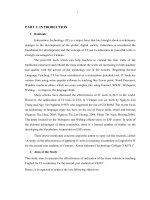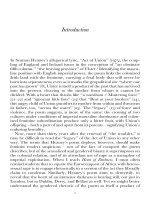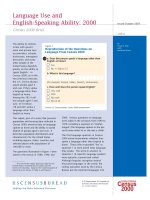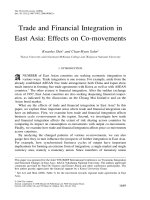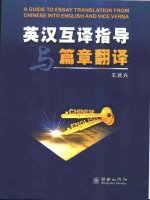Interference and integration effects on auditory and visual information differences between chinese and english
Bạn đang xem bản rút gọn của tài liệu. Xem và tải ngay bản đầy đủ của tài liệu tại đây (474.53 KB, 92 trang )
INTERFERENCE & INTEGRATION EFFECTS ON AUDITORY
& VISUAL INFORMATION:
DIFFERENCES BETWEEN CHINESE & ENGLISH
An Academic Exercise
Prepared for the
Faculty of Business Administration
NATIONAL UNIVERSITY OF SINGAPORE
In Partial Fulfillment of the Requirements for the
Master of Science (Management) Degree
By
TAN THOR LING
2002/2003
ABSTRACT
Written language is central to branding and marketing communications (Tavassoli & Han
2001) in modern society of consumerism, and the use of words and writing are key tenets in the
development of brand identity for many products and services. Brand identity may consist of
language components such as a brand name itself, brand slogans and verbal advertising
messages. Majority of past advertising studies pertaining to memory have been conducted in an
English-only context, implicitly assuming that advertising information is processed similarly
across languages. However, while Chinese logographic characters represent meanings, English
script contains symbols that represent sounds (Tavassoli & Han 2001), and such structural
contrasts between Asian and Western languages have been shown in separate studies to
differentially affect how information is processed (Gathercole and Baddeley 1993; Zhou &
Marslen-Wilson 1999).
Other factors that may potentially moderate the linguistic processing of a branding or
advertising message also include the audio-visual representation of message and the interitem
relevancy within a message. Hence, the present study seeks to improvise on past research and
reexamine linguistic script differences and their effect on auditory and visual processing under
relevant identifier conditions.
With China being increasingly recognized as a global economic force, it is an observation
that many companies are keen to conduct commerce in the Asian region. Knowledge about the
discrepant impact of language on information-processing and memory representation is therefore
of practical interest to businesses interested in successfully penetrating the Chinese consumer
market through effective branding and cross-language communication strategies.
TABLE OF CONTENTS
Abstract
Table of Contents
CHAPTER ONE - INTRODUCTION
1.1 Motivation of Study ………………………………………………………..
2
1.2 Furthering Past Research ..………………………………………………..
3
1.3 Research Objectives ..……...………………………………………………
5
CHAPTER TWO – LITERATURE REVIEW
2.1 Introduction ………..….……………………………………………………
7
2.2 Language Processing ………………………………………………………
2.2.1 Structural Differences between English and Chinese
2.2.2 Phonological Differences in Reading English and Chinese
2.2.2.1 Phonology in English
2.2.2.2 Phonology in Chinese
2.2.3 Visual (Graphic) Differences in Reading English and Chinese
2.2.3.1 Visual Processes in Reading English
2.2.3.2 Visual Processes in Reading Chinese
2.2.4 Effects of Language Processing on Memory Representation
2.2.4.1 English Processing and Memory
2.2.4.2 Chinese Processing and Memory
7
7
8
8
9
10
10
10
11
11
11
2.3 Information Processing and Memory …….………………………………
2.3.1 Integration
2.3.1.1 Integrating English with Auditory Information
2.3.1.2 Integrating Chinese with Auditory Information
2.3.2 Interference
2.3.2.1 Interference between English and Auditory Information
2.3.2.2 Interference between Chinese and Visual Information
2.3.3 Integration and Interference
12
12
13
14
14
15
15
16
2.4 Integration: Language and Visual & Audio Identifiers ………………...
17
2.5 Relevancy and Integration ………………………………………………..
2.5.1 Effects of Relevancy on Memory Representation
2.5.2 Effects of Relevancy on Information Processing
18
18
19
2.6 Interference: Language and Visual & Audio Identifiers ……………….
21
2.7 Summary …………………………………………………………………...
24
CHAPTER THREE - METHODOLOGY
3.1 Introduction ………….……………………………………………………..
27
3.2 Design …………………. ....................………………………………………
27
3.3 Manipulation of Independent Variables (IVs) …………………..………
3.3.1 Selection of Attributes
3.3.2 Relatedness of Attribute-Identifier Pairs
27
28
30
3.4 Experimental Procedure …..……………………………………………….
34
3.5 Testing of Dependent Variables (DVs) ……………………………………
3.5.1 Retrieval Memory (Free Recall)
3.5.2 Relational Memory ( Fair Recognition)
37
37
37
3.6 Manipulation Check ……………………………………………………….
38
CHAPTER FOUR – ANALYSIS
4.1 Introduction …………………………………………………………………
40
4.2 Covariates …………………………………………………………………..
40
4.3 Integration & Relational Memory (Recognition) ………………………...
40
4.4 Interference & Retrieval Memory (Recall) ……………………………….
45
CHAPTER FIVE – DISCUSSION
5.1 Introduction ………………………………………………………………..
50
5.2 Findings ……………………………………………………………………...
50
5.3 Theoretical Implications ……………………………………………………
51
5.4 Managerial Implications …………………………………………………...
56
5.5 Future Research …………………………………………………………….
58
5.6 Conclusion …………………………………………………………………..
60
APPENDIX
BIBLIOGRAPHY
Chapter One
Introduction
1
1. INTRODUCTION
1.1 MOTIVATION OF STUDY
Written language is central to branding and marketing communications (Tavassoli & Han
2001) in modern society of consumerism, and the use of words and writing are key tenets in the
development of brand identity for many products and services. For example, brand identity
commonly consists of language components such as a brand name itself (e.g. Nike) and brand
slogans (e.g. Nike’s “Just Do It”).
With Asia emerging as a major economic force - in particular reference to China and its
entry into the World Trade Orgnization (WTO) - at the turn of the century, many business
organizations are waking up to the fact that approximately one-quarter of the world’s population
communicates in a language that is starkly different from the modern, alphabetic English script
that American-influenced branding is familiar with. Many advertising studies pertaining to
memory have been largely conducted in single-language – typically English – conditions,
implicitly assuming that consumers around the globe process verbal brand information
identically across tongues. Such a presumption may be erroneous: while Chinese logographic
characters represent meanings, modern English scripts contain symbols that represent sounds
(Tavassoli & Han 2001), and such structural dissimilarities between Asian and Western
languages have been shown in separate studies to differentially affect how information is
processed (Gathercole and Baddeley 1993; Hung & Tzeng 1981; Zhou & Marslen-Wilson 1999)
and represented in memory (Schmitt, Pan & Tavassoli 1994). Thus, knowledge on the discrepant
impact of language on information-processing and memory representation is of practical interest
to foreign businesses keen on successfully penetrating the Chinese consumer market through
effective branding and communication strategies.
2
Naturally, language elements are not the only considerations in the creation of a
successful brand identity. Impactful brand identifiers also often include the use of logos – or
visual representations of a brand name (Shennan 1986), such as the Nike “SWOOSH” design –
and jingles or auditory cues to a brand name (Croft 1999), such as the Nike “SWOOSH” sound.
Advertisements – whether in print or in multimedia form – often consist of both verbal (i.e.
language) and visual (e.g. pictures, logos, etc) or audio accompaniments (e.g. voices, jingles,
etc). Hence, investigation into the possible interactions between language and audiovisual brand
identifiers is also critical to provide an accurate analysis of varying linguistic effects on memory
representation.
1.2 FURTHERING PAST RESEARCH
A couple of past studies have accounted for the influence of linguistic differences
between alphabetic and logographic script on interactions with audio-visual stimuli and
mnemonic performance. In a cross-cultural experiment utilizing Chinese and American students
from Beijing and Chicago respectively (Schmitt, Pan & Tavassoli 1994), it was showed that
memory recognition will be differentially affected by whether Chinese or English words were
learned auditorally or visually. In another noteworthy experiment conducted on monolingual
Koreans - with language differences manipulated through the use of alphabetic Korean Hangul
and logographic Korean Hancha (Tavassoli & Han 2001) – it was demonstrated that memory for
Chinese and English words will be affected by whether an audio or visual brand identifier was
matched to the word.
Although research findings have proved remarkable, this study aims to improve upon
their inherent limitations that arise from the necessary use of monolingual subjects in the two
3
above-mentioned studies. The first limitation is the fact that cross-cultural experiments may be
somewhat limited by the host of factors that may differ between populations; differences that
naturally occur when subjects in a single study consist of both Chinese speakers living in China
and English speakers living in the United States. These factors comprise of educational
differences that can affect memory rehearsal strategies, cultural factors that can affect the
evaluation of certain product characteristics as well as responses to nonverbal audiovisual
stimuli. Secondly, single-language manipulations (e.g. comparisons within Korean Hangul and
Hancha) may not prove as conclusive or as generalizable as across-language manipulations.
In contrast to monolinguals, proficient bilinguals rely on different scripts to access a
single conceptual system (Francis 1999; Chen & Leung 1989). Proficient bilinguals have also
been found to comprehend written languages significantly faster than monolinguals, and to be
more advanced in terms of memory representation (Bialystok 2003). The use of bilingual
subjects’ will therefore produce a more accurate and true assessment of findings in any
experiment involving language processing and memory representation. In addition, the use of
bilinguals’ living in the same country also simultaneously controls for cross-cultural differences
while allowing for across-language manipulations. In Singapore, Chinese students are educated
in both English and Chinese tongues from the time they are 6 years of age. Hence, in this study,
bilingual 16-year-old high school students (i.e. have received a minimum of 10 years learning
instruction in both the English and Chinese language) were roped in for participation in the
experiment.
Both the earlier studies mentioned also made use of “nonsensical” stimuli - such as odd
shapes and meaningless sounds – in their experimental setup. However, practically speaking,
very rarely do business organizations and advertisers utilize (i) nonsensical, meaningless brand
4
identifiers, or (ii) irrelevant stimuli in their marketing communications. Thus, while much of past
research has partially-restricted real-world marketing and branding implications, this study seeks
to provide further business-managerial considerations through modified experimentation of past
studies with the improvised use of relevant identifiers.
1.3 RESEARCH OBJECTIVES
Marketers often struggle to find a dynamic combination of words and pictures and/or
sounds that will convey their overall advertising message powerfully and effectively to their
target audience. Naturally, choice words and verbal messages are often paired with relevant,
meaning-laden information for greater impact. For example, BMW car advertisements often seek
to communicate the idea of a BMW being “The Ultimate Driving Machine”, and their television
advertisements typically pair this verbal message with both visual sights of a sleek BMW cruising
on the road and auditory sounds of an engine roaring powerfully as the BMW speeds past on the
screen.
Hence, the present study seeks to reexamine linguistic script differences and their effect
on auditory and visual processing under relevant identifier conditions. It is hoped that findings
will produce a realistic representation of the true effectiveness of day-to-day marketing
communications, and provide practical managerial recommendation in the development of crosslanguage advertising communication strategies.
5
Chapter Two
Literature Review
6
2. LITERATURE REVIEW
2.1 INTRODUCTION
This study basically seeks to determine the impact that processing of marketing stimuli –
with variations in language, brand identifiers, relevancy of attribute-identifiers and product
category - will have on bilingual audiences; as such, an in-depth review of psycholinguistic and
memory integration-interference literature will be discussed in this chapter.
2.2 LANGUAGE PROCESSING
Due to inherent structural differences between English alphabetic script and Chinese
logographic characters, there are contrasting degrees of phonological (audio) and orthographical
(visual) processes involved in the reading of words in either language. These disimilarities also
affect the route by which English and Chinese words are represented in memory.
2.2.1 STRUCTURAL DIFFERENCES BETWEEN ENGLISH & CHINESE
Like most languages, English relies on an alphabetic script where letters represent
sounds. The English language only consists of 26 letters, which can be put together to create an
infinite number of words. In such alphabetic writing systems, meaningless basic symbols (i.e.
letters or alphabet) are made more or less corresponding to pronunciation units (i.e. words) in
speech (Chen, Flores d’Arcais and Cheung 1995) based on sounds.
Chinese is a form of logographic writing system in which the characters represent basic
units of meaning (Chen, Flores d’Arcais and Cheung 1995), with at least 7,000 distinct and
unique logographic representations available (Tavassoli 1999). 82% of Chinese characters fall
into a category labelled as compound characters (Zhou 1978). Compound characters consist of
7
two separable subcomponents (called radicals): the semantic radical usually provides a
categorical cue to the meaning of a whole character, while the phonetic radical sometimes
provides clues to the pronunciation of the whole character (Zhou 1978; Xu, Pollatsek & Potter
1999).
2.2.2 PHONOLOGICAL DIFFERENCES IN READING ENGLISH AND CHINESE
Reading English is more dependent on phonological sound-based processes than in reading
Chinese, largely because of the inherently pronunciation-linked composition of the English
language:
2.2.2.1 Phonology in English
Due to the the linguistic structure of the English language, the written form and its
pronunciation are linked by rules because the sequence of letters that make up an English word
corresponds to specific sounds (Schmitt, Pan & Tavassoli 1994). As such, English spelling is
inextricably coupled with phonemic identity (Schmitt, Pan & Tavassoli 1994), and the English
alphabetic writing system thus allows quick access to phonological information from
orthography (Feng, Miller, Shu & Zhang 2001). Many studies on English word recognition have
shown early, automatic phonological activation when English words are presented to subjects in
isolation (Frost 1998, for review). Hence, phonology plays a central role in the processing of
English.
8
2.2.2.2 Phonology in Chinese
Even though most Chinese chacters are prototypically picto-phonetic (Yin & Rohsenow
1994) – earlier decribed as consisting of one component that represents pronunciation and a
second component that represents meaning - the validity of the phonological cues from phonetic
radicals are frequently low (Feng, Miller, Shu & Zhang 2001). It has been estimated that only
26% to 39% of phonetic radicals accurately predict the pronunciation of the whole Chinese
character (Zhou 1978; Gao, Fan & Fei 1993). This loose graphic-phonemic correspondence that
is characteristic in the Chinese language (Schmitt, Pan & Tavassoli 1994) means that
orthographic, or structural, cues to phonology are ambiguous (Tavassoli 1999) and less useful in
Chinese than in English (Feng et. al 2001).
In addition, the Chinese language consists of a large number of homophones - or words
that sound the same but have different meanings (Tavassoli & Han 2001) – such as to, too, two in
English. As testimony to this, although Chinese contains 300 times as many character symbols as
English, the former language utilizes only approximately 400 syllables compared to 4,000 in
English (Xindai Hanyu Pinyin Cidian / Modern Chinese Dictionary 1997). The extensive
number of homophones present in the Chinese vocabulary implies that many characters share the
same pronunciation (Tan, Hoosain & Peng 1995) and that there is rarely a unique linkage from a
single character to a syllable for pronunciation (Feng et. al 2001), thus further suggesting that
phonology is not very helpful in distinguishing Chinese characters (Aaronson and Ferres 1986).
9
2.2.3 VISUAL (GRAPHIC) DIFFERENCES IN READING ENGLISH AND CHINESE
Reading Chinese is more contingent on visual processes than in reading English, mainly due to
the visually-logographic formation of basic Chinese units (i.e. characters).
2.2.3.1 Visual Processes in Reading English
As earlier established, reading English is primarily a sound-based process. In English
writing, homophonic mistakes such as inserting the word “vein” for “vain” often go unnoticed by
test subjects (Daneman & Stainton 1991), thus demonstrating that visual processes are of lesser
importance than auditory processes in the reading of English script. The role of visual processing
in English may be thought of as being limited to a shallow identification of English orthography,
that after initial recognition allows a phonological process to convert written strings to phonemic
strings (Feldman & Turvey 1983; Frost, Katz & Bentin 1987; Katz & Feldman 1983).
2.2.3.2 Visual Processes in Reading Chinese
The Chinese language comprises of basic units (i.e. characters) that are composed via a
visual arrangement of strokes with ideographic origins (Schmitt, Pan & Tavassoli 1994). The
visual similarity between these Chinese characters are low (Feng et. al 2001), hence Chinese
readers tend to depend more on identification of the unique visual features of Chinese
logographic characters in reading (Aaronson and Ferres 1986). With this inclination to reliance
on physical orthographic cues of the language, Chinese readers can build up strong graphic-form
semantic associations which are quite deterministic (Perfetti & Tan 1998).
In addition, because syllable information is incomplete and unsystematic (i.e. low phonetic
prediction rate), a Chinese reader can - in principle - read words by going directly from graphic
10
writing units to meanings (Perfetti & Tan 1998). Reading Chinese has been established to be a
visual form-to-meaning process (Baluch & Besner 1991; Frost 1994), and this visual dependency
in reading Chinese has been demonstrated in past experiments that have shown Chinese
consumers to be more sensitive to visual features of written Chinese words (Tavassoli 2001).
2.2.4 EFFECTS OF LANGUAGE PROCESSING ON MEMORY REPRESENTATION
The structural and linguistic differences between English and Chinese will naturally affect
the mental representations of information, and in turn, influence consumer memory (Schmitt,
Pan & Tavassoli 1994).
2.2.4.1 English Processing & Memory
Due to the greater involvement of acoustics inherent in the characteristic of the English
language, readers of English tend to sub-vocalize – or phonologically recode – written words
(McCusker, Hillinger and Bias 1981) and rehearse words using a sound-based mental code in a
subsystem of short-term memory known as the phonological loop (Baddeley 1986; Pavio 1986).
Processing the alphabetic English script relies more heavily on the storage and serial rehersal
properties of short-term memory’s phonological loop (Tavassoli and Han 2001). In contrast to
Chinese processing, routine English language processing does not appear to reply on visual
short-term memory, other than through mental imagery (Gathercole and Baddeley 1993).
2.2.4.2 Chinese Processing & Memory
Readers of Chinese are able to mentally access concepts unmediated by sub-vocalization,
although the activation of pronunciation may be immediate and can also mediate the activation
11
of meaning (Perfetti and Zhang 1991). In other words, readers’ association with pronunciation
when processing Chinese words is arbitrary, and unsystematically acquired via rote associative
learning (Tavassoli and Han 2002). Hence, reading Chinese is not dominated by sound-based
processes, and phonemic recording in processing Chinese is used much less, if at all (Sasanuma
1973).
In contrast to the sound-based dependence involved in the processing English, reading
Chinese appears to rely on visual processes to a greater degree than reading English (Hung &
Tzeng 1981, Zhou & Marslen-Wilson 1999). The processing of characters written in such
logographic scripts relies more on the storage of and the spatial relational rehearsal properties of
visual short-term memory (Tavassoli & Han 2001), and Chinese characters are encoded visually
and mapped onto images directly.
2.3 INFORMATION PROCESSING AND MEMORY
Depending on the degree of shared or separate mental resources required for various
processing activities, an individual’s performance in undertaking two tasks simultaneously
would be affected: by whether common resources could be integrated for efficient processing
(Wickens 1984), or whether competing demands on resources would interfere with performance
(Kinsbourne and Hicks 1978).
2.3.1 INTEGRATION
There has been much research examining the effects of the integration of words with
acoustic and visual information (Massaro 1996; Treisman 1988). To generalize, the degree to
which efficient integration between features of an item can occur is when there is a shared
12
directness between the processes that are used to encode the features (McClelland 1996). For
example, it has been shown that words that had been presented in the same modality (either
spoken or written) were better memory cues than words that were presented in different
modalities (Penney and Butt 1986). Similarly, consumers performed better at a pair-recognition
task involving integration of brand names and product categories in memory, when these were
learned in the same modality than in different modalities (Tavassoli 1998). In addition,
associative memory in coordination tasks – like when a pilot needs to integrate visual, auditory
and verbal information to make a cognitive decision – has been found to be greater when there is
a larger processing overlap (Yee, Hunt and Pellegrino 1991).
In summary, relational memory (memory which involves integration of two distinct
items) should be stronger the more two stimuli rely on similar encoding processes (Tavassoli and
Han 2001).
2.3.1.1 Integrating English with Auditory Information
As earlier discussed, reading English relies largely on phonological or accoustic
mechanisms (Schmitt, Pan & Tavassoli 1994); hence, the cognitive resources required for the
processing of English are similar to mental resources required for auditory processing. It
therefore follows that auditory stimuli should be integrated into memory more strongly with the
alphabetic English (Tavassoli & Han 2001). For example, it has been shown that in English,
mistakes and decrements have been observed in the recall of accoustically similar verbal stimuli,
but not visually similar verbal stimuli (Baddeley 1981; Rubenstein, Lewis & Rubenstein 1971),
and English consumers were found to be more sensitive to auditory cues such as a speakers’
13
voice (Pan & Schmitt 1996). Thus, the greater reliance on phonological resouces faciliates
integration between two separate pieces of verbal-English and sound-based information.
2.3.1.2 Integrating Chinese with Visual Information
Similarly, because reading Chinese depends heavily on
visual processes, cognitive
resources required for processing both Chinese and graphic information coincide with each
other. Hence, visual logos should be integrated into memory more strongly with logographic
Chinese (Tavassoli and Han 2001). It has been found that memory for the print color of Chinese
brand names was greater than in English (Tavassoli 1999), and that Chinese subjects were more
sensitive to visual cues such as font type (Pan & Schmitt 1996). Past experiments have also
shown that regardless of whether words were learned auditorily or visually, Chinese speakers
were able to recollect them better by writing it down; researchers have suggested that the attempt
to write the Chinese characters serves as a prime for the Chinese logographs’ visually-integrated
memory code (Schmitt et. al 1994). Hence, Chinese characters are more easily integrated with
visual information in memory due to the overlap in visual processing resources involved.
2.3.2 INTERFERENCE
The reciprocal effect of information integration may be thought of as interference
(Penney 1989; Tavassoli 1998), and interference may be regarded as whatever impedes an
individual from effectively processing a stimulus (Wickens 1984). When stimuli compete for
attention - such as in a dual task setting – the interference generated is greater the larger the
overlap in cognitive resources required for effective processing (Tavassoli & Han 2001). For
example, it has been shown that auditory ads interfere more with recall memory for competitive
14
auditory ads than with recall memory for visual ads (Unnava and Sirdeshmukh 1994). In
contrast, it is easier to perform two competing tasks concurrently when one is auditory and the
other is visual (i.e. because separate mental resources are expended in the processing of audio
and visual information), than when both are in the same modality (Tresiman and Davies 1973).
2.3.2.1 Interference between English and Auditory Information
Based on the assumptions underlying the described interference theory, the overlapping
phonologically-based resources required for the processing of both audio information and
English will result in greater memory interference between auditory stimuli and the English
alphabetic script (Tavassoli & Han 2001). Past experiments have demonstrated that acoustic
distractors in English stimuli will interfere more with the processing of verbal than pictorial
information (Duncan 1980), and that auditory elements will interfere more with the learning of
and cognitive responding to English than Chinese ad copy due to the modality-specific (i.e.
phonological) overlap in mental resource requirements (Unnava, Agarwal, and Haugtvedt 1996).
2.3.2.2 Interference between Chinese and Visual Information
Due to the greater dependence on visual resources in the processing of logographic
scripts like Chinese, visual stimuli will show more interference in memory with Chinese than
with English (Tavassoli & Han 2001). Research has found that interference in naming a words’
print color is greater if the conflicting color word (e.g., the word “BLUE” is visually printed in
the ink-color red) is written in logographic Chinese than alphabetic English (e.g., Biederman &
Tsao 1979), thus suggesting that perceptual or visual interference is higher in Chinese – as
opposed to English – conditions. Other supporting experiments in the same vein have shown that
15
the use of visual symbols produced more interference in the naming of Chinese characters than
in the naming of English words (Chen & Tsoi, 1990), and that Japanese native speakers also
showed more interference when color names were written with logographic Kanji characters than
with phonemic Kana script (Morikawa 1981).
2.3.3 INTEGRATION & INTERFERENCE
In summary, memory integration may be thought of as a process that occurs when
mnemonic encoding is facilitated by the presence of overlapping of features between two distinct
items (McClelland 1996). Relational memory may be thought of as memory formed as an
association between two separate pieces of information, and has been used in past research as an
experimental measure of integration (Tavassoli & Han 2001). In the authors’ experiment,
subjects were shown combinations of visual words, and a visual or auditory stimulus. Relational
memory was tested by soliciting subjects’ paired-recognition of word-stimulus pairs that were
later shown to subjects again. Hence, paired-recognition is directly proportional to integration;
recognition is higher the more two stimuli rely on similar encoding processes (Du Plessis 1994).
As opposed to item recognition which does not depend on memory retrieval processes,
individual capacity for free recall is lower when competitive information is presented in the same
modality (Tavassoli 1998). Hence, recall may be considered to be inversely proportional to
interference: the higher the occurring level of memory interference, the lower the memory recall
capacity of an individual. Recall tasks involve asking consumers to report what they have seen
without any cues (Du Plessis 1994), and may therefore be used as an indirect measure of
interference
16
2.4 INTEGRATION: LANGUAGE AND VISUAL & AUDIO IDENTIFIERS
Based on the literature reviewed above, it is apparent that alphabetic scripts are processed
in the phonological loop to a greater degree than logographic words are; hence, auditory cues
should facilitate the encoding of memory relations between English words and auditory brand
identifiers. In contrast, the greater reliance on visual processing in the processing of logographs
should make easier the coding of memory association between Chinese logographs and visual
brand identifiers. In previous research involving a monolingual Korean population (Tavassoli &
Han 1999), it has been demonstrated that auditory identifiers are integrated in memory more
strongly with alphabetic script (i.e. Korean Hangul script), while visual logos are integrated in
memory more strongly with logographic words (i.e. Korean Hancha characters).
In replication of the above findings on a bilingual Singaporean sample, it is therefore
proposed that:
H1: When stimulus identifiers are neutral - or possess no related or meaningful association –
with respect to the target words,
(a): Relational memory between English words and auditory identifiers should be stronger than
with visual identifiers, and
(b): Relational memory between Chinese words and visual identifiers should be stronger than
with audio identifiers.
17
FIGURE 2.1
REPRESENTATION OF HYPOTHESIS H1
Relational
Memory
Relational
Memory
Chinese (H1b)
English (H1a)
Audio
Identifier
Visual
Identifier
Audio
Identifier
Visual
Identifier
2.5 RELEVANCY & INTEGRATION
Relevancy may be defined as the extent to which material pertains directly to the meaning
of the theme and reflects how the information contained in the stimulus contributes to or detracts
from the clear identification of the theme of primary message being communicated (Goodman
1980).
2.5.1 EFFECTS OF RELEVANCY ON MEMORY REPRESENTATION
Past research has shown that congruent items are easily comprehended and integrated
with previous expectations (Heckler and Childers 1992), while the use of irrelevant items lead to
minimal development of ‘inter-episode’ linkages, resulting in limited information-processing that
makes irrelevant items least likely to be integrated. As such, meaningful associations can
enhance memory (Lutz and Lutz 1997; Schmitt, Tavassoli & Millard 1993) and facilitate the
encoding of thematic information (Meyers-Levy 1991). For example, it has been demonstrated
18
that ads containing relations among the ad elements – such as brand name, copy and pictures –
were better recalled than those containing unrelated ad elements (Schmitt, et al 1993).
In short, when elements of a stimulus set complement other items within the set, memory
representation is reinforced due to the facilitation of inter-item integration (Pomerantz 1981).
This directly means that relevant stimuli can be easily associated with other information
presented in the same message, and that relevant pairs can be more effortlessly recalled and
recognized.
2.5.2 EFFECTS OF RELEVANCY ON INFORMATION PROCESSING
As the use of relevant pairs generally allows for enhanced integration in memory, it
follows that when relevant identifiers are used in conjunction with Chinese logographs or
English script, it should greatly facilitate encoding of target words in either language. It is
therefore predicted that the presence of relevant identifiers should reduce effects of processing
advantages between English-Audio and Chinese-Visuals - over English-Visual and Chinese
Audio respectively - that would otherwise be displayed in a neutral condition.
In other words, due to the greater reliance on phonological-audio processing involved in
the reading of English words (Schmitt, Pan & Tavassoli 1994), relational memory strength
between English words and auditory stimuli can be assumed to be inherently superior to
relational memory strength between the former and visual stimuli. As relational memory for
association between English words and audio objects is already naturally stronger, it is proposed
that introducing relevant identifiers – or identifiers that possess related or meaningful
associations to the target word – should not significantly enhance relational memory between
English words and audio stimuli.
19
On the other hand, relational memory for pairings between verbal English and visual
objects – with the former relying on phonological processes and the latter on visual processes - is
generally weak as there is no overlap in encoding processing (Tavassoli & Han 2001). It is
therefore logical to hypothesize that relational memory will be significantly improved for target
English words that are paired with relevant visual stimuli. Hence:
H2: The incremental effects of relevancy on relational memory will be significantly higher under
English-Visual than English-Audio conditions.
Likewise, with greater dependence on visual processing involved in the reading of
Chinese words (Hung & Tzeng 1981), relational memory strength between Chinese words and
visual stimuli can be given as innately better enhanced in comparison to relational memory
strength between Chinese words and audio stimuli. It is similarly suggested that introducing the
variable of relevancy will not facilitate relational memory between Chinese logographs and
visual identifiers, whereas relational memory has greater room for significant improvement for
Chinese words that are paired with relevant visual stimuli.
H3: The incremental effects of relevancy on relational memory will be significantly higher under
Chinese-Audio than Chinese-Visual conditions.
20

